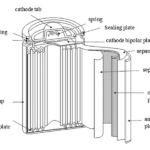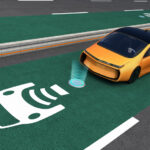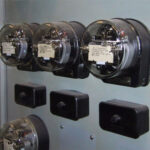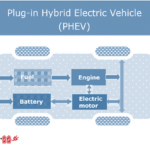Conventional vehicles that rely on internal combustion engines (ICE) could become a rarity in the next couple of decades. Electric vehicles (EVs) are growing in popularity, replacing petrol-driven transportation faster than expected. Despite a higher initial price tag, EVs typically offer savings over time. The environmental benefits aside (which are noteworthy), EVs cost half as much to maintain and repair as gas-powered vehicles over time.
Instead of an ICE, electric vehicles have a power train comprising of a battery pack, an inverter, a transmission, and electric motors. When a driver accelerates, the battery pack supplies electricity to the stator of the electric motor. This powers the rotor, which turns the gear mechanism and the wheels. The speed and torque of the engine are controlled by a power electronic controller (PEC) and gear motor.
The battery pack and electric motor are the key components of an electric vehicle.
Although different EVs (such as cars compared to buses) use different types of electric motors, the features of the motor should provide high starting torque, strong traction, power density, and high efficiency and reliability. Ideally, it will also offer low cost and maintenance.
Next, we’ll discuss the different types of electric motors used in electric vehicles and compare their use cases.
Electric motors
You might think that induction motors are the go-to choice for EVs, and you’d be correct for the most part. Induction motors are typically used, but they’re not the only choice. Choosing the ideal motor for manufacturers is a complex process that depends on the type of vehicle and involves R&D.
Other electric motors in EVs include brushed DC, brushless DC, permanent-magnet synchronous, three-phase AC induction, and switched reluctance motors. Both DC and AC motors are used to power electric vehicles.
Asynchronous and synchronous motors are used depending on various factors. Let’s explore some of these choices in greater detail.
DC vs. AC motors
To be effective, any electric motor must also be a traction motor — in other words, it must have a high starting torque to move forward and manage hills. DC motors offer the best torque even at a low rpm. The control circuitry for DC motors is also simple.
Despite these advantages, DC motors (whether brushed or brushless) are not widely used in EVs because these motors are heavy and hefty in size, which is a major drawback. The lighter the EV, the less strain on the battery. Reliability and maintenance are also concerns with DC motors. Their use is typically limited to e-rickshaws and some two-wheelers, which can be driven at low speeds.
High torque at low speed enables DC motors to run at a constant speed, regardless of the load.
EVs that are meant for day-to-day mobility typically use AC induction motors. Induction motors offer high efficiency and low maintenance at a reasonable cost — plus, they’re lightweight. AC motors also have regenerative capabilities, allowing the battery to benefit from the energy expelled during braking and recharge.
Traction motors and self-relieving property
One important characteristic of traction motors is self-relieving. This means speed and torque are inversely proportional to one another. When the speed increases, the torque reduces, and vice versa.

The power output of the motor is equal to the product of torque and speed.

The self-relieving property of a traction motor protects it from overloading. When a traction motor begins rotating, it should deliver a constant torque while its speed increases gradually. Eventually, it’ll reach an optimum driving speed, but the torque must also be maintained. This is called the base speed of the traction motor.
Beyond the base speed, the torque drops while maintaining a constant power output. However, this implies that the speed increases at the cost of torque. The traction motor has the maximum torque and the highest power output at the base speed. This is the point where an electric motor is at maximum stress. So, at any rate past the base, the motor recovers stress by increasing the speed while reducing the torque.

The overall performance of an electric vehicle depends upon its motor’s torque-speed and power-speed characteristic curve. A traction motor performs two distinct types of operation:
1. Constant torque. A healthy motor provides the maximum torque when it begins rotating and should maintain this same torque until it reaches the base speed. This is the region where an EV accelerates after stopping.
2. Constant power. When the motor accelerates at the cost of torque, it determines the maximum speed of the motor. The constant power determines the speed range of an EV.
The constant torque and constant power region of a traction motor operate inversely. Typically, engineers attempt to balance and maximize the acceleration performance and speed range of an EV.
Ideally, the motor delivers maximum torque at a low speed. This means that once the base speed is reached, the engine maximizes the vehicle’s speed range at a constant power — without compromising the torque.
As mentioned, every manufacturer’s goal is a lightweight electric vehicle with high starting torque and power efficiency. But no electric motor is perfect. There will be compromises made between the torque, acceleration, and speed.
Brushed DC motors
DC motors ensure high torque at low speeds. These motors can withstand variable loads and rotate at a constant speed despite sudden changes in load. They offer excellent acceleration performance but limited speed capabilities. This is because DC motors use brushes and commuters, limiting the maximum speed attainable.
Low power efficiency and poor reliability are other drawbacks of brushed DC motors. Size is also an issue with these motors, which are big and bulky. Brushed DC motors were initially used in e-rickshaws and electric three-wheelers, but have since been replaced with brushless DC motors.
Brushless DC motors
Rather than brushes and commuters, brushless DC motors have permanent magnets, proving a power efficiency as high as 95~98% while delivering similar torque. They also offer a high starting torque and variable load capacity.
Brushless motor either incorporate an out- or in-runner configuration. The rotor is outside the motor in an out-runner while the stator is inside. This type of configuration is a hub motor, which does not require any external gear mechanism. The motor directly rotates the wheel, so there’s maximum power transfer.
But this limits the use of the motor in terms of a maximum power rating. The power output cannot be compromised with vehicle stability. As a result, an out-runner motor often has built-in planetary gears for speed variation.
For the in-runner motor, the reverse is true — the rotor is located on the inside while the stator is on the outside. This configuration requires an external transmission to transfer mechanical energy to the wheels. The biggest drawback of in-runner motors is their size and weight.
Brushless DC motors are ideal for electric vehicles that drive at a low speed with variable loads. DC motors provide the best torque, but using permanent magnets limits speed. The permanent magnets are also subject to high maintenance and can break in harsh conditions.
Permanent magnet synchronous motors
Permanent magnet synchronous motors (PMSM) are brushless DC motors where the rotor winding is replaced by a permanent magnet. These motors offer higher efficiency than induction motors because there are no rotor losses. They also offer high power density, but the constant power region is relatively short, and the torque is limited.
The PMSM’s short constant power is typically elongated by adjusting the conduction angle control. This enables it to achieve a maximum speed that’s three to four times the base speed.
One unique advantage of PMSM is that they have a sinusoidal back EMF (electromotive force). This differs from the trapezoidal back EMF typically found in brushless DC motors. Sinusoidal ack EMF is a voltage generated by the rotation of the motor, which opposes the applied voltage. It’s useful because it lets the battery recharge (when braking) using a regenerative ability.
The disadvantage of permanent magnets is their poor durability to withstand variable temperatures. Safety is a concern, as permanent magnets can break under harsh conditions. They’re also not cheap. However, thanks to their high efficiency, PMSMs are widely used in EVs that carry a limited load but require a high power output.
Induction motors in EVs
Induction motors are the most commonly used motors in EVs today. They have a simple design, low maintenance requirements, low cost, and offer reliability in different environmental conditions compared to DC motors.
The torque of an induction motor is adjustable using the voltage/frequency or field-oriented control method. This enables a high starting torque in three-phase induction motors. Since the torque is adjustable, a maximum load capacity can still be guaranteed over a wide speed range. The speed range is usually increased by using dual inverters. The motor can also be de-exited even if the inverter fails, providing additional safety.
Compared to PMSM, induction motors have a slightly lower power efficiency of 92~95%. This means a larger battery pack would be needed to meet the same power requirements.
Other drawbacks of induction motors include higher power losses, lower power output, and the need for more complex power electronics and inverter circuits. But because of their reliability, environmental robustness, and low cost, these are the preferred choice in most EVs and e-scooters.
Switched reluctance motor in EVs
The switched reluctance motor (SRM) uses a piece of laminated steel without any copper winding as the rotor. It does not use copper winding or permanent magnets. This leads to a more straightforward construction with several advantages.
These motors have no copper losses in the rotor and have lower inertia, so the motor does not easily overheat. The lack of inertial losses means it also achieves high acceleration performance. This motor provides high power density with a wider constant power region and a greater speed range.
The lack of permanent magnets adds mechanical reliability at high speeds and high temperatures.
SRMs provide an ideal combination of acceleration performance, high power efficiency, wide speed range, and low maintainability. The biggest drawback of these motors is their complex control circuitry and noise — they can be loud. Once these cons are rectified, SRMs will likely take little time to replace induction and PMSM motors in electric vehicles.
Conclusion
For low-speed electric vehicles, brushless DC motors are the preferred motors due to their high starting torque and variable load capacity. Heavy EVs like buses generally use PMSMs. Induction motors are commonly used in electric cars and electric scooters. The SRMs provide the best combination of acceleration performance, speed range, power efficiency, reliability, and low maintenance. Engineers still must sort out issues with SRMs in terms of complex control circuitry and noise control before they replace induction motors and PMSMs commercially.
You may also like:
Filed Under: Electric Vehicles, EVs, Tech Articles, Tutorials








Questions related to this article?
👉Ask and discuss on EDAboard.com and Electro-Tech-Online.com forums.
Tell Us What You Think!!
You must be logged in to post a comment.